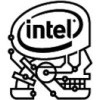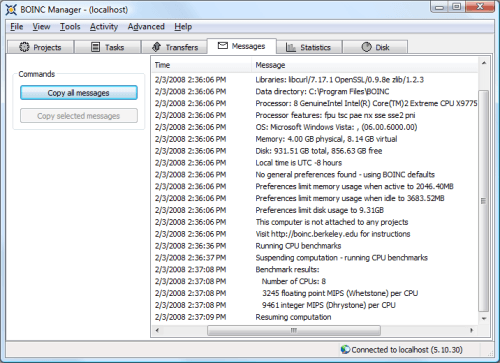- Qualcomm Launches Snapdragon 4 Gen 2 Mobile Platform
- AMD Launches Ryzen PRO 7000 Series Mobile & Desktop Platform
- Intel Launches Sleek Single-Slot Arc Pro A60 Workstation Graphics Card
- NVIDIA Announces Latest Ada Lovelace Additions: GeForce RTX 4060 Ti & RTX 4060
- Maxon Redshift With AMD Radeon GPU Rendering Support Now Available
Intel Skulltrail Enthusiast Platform Preview

Consisting of two Extreme Quad-Core processors, Intel is looking to redefine what we know as “high-end”. Skulltrail is touted as being the “ultimate” enthusiast platform, offering SLI and Crossfire support, huge overclocking abilities and enough sheer power to make the competition weep.
Page 2 – Putting Eight Cores to Good Use
When Intel launched their V8 platform last year, it was very similar in design to Skulltrail, however it was still more of a server-based platform than anything, whereas Skulltrail is tweaked for the enthusiast. Everything is fast here… faster CPUs, faster RAM and dual-GPU capabilities. It looks to be an ultimate gaming rig / workstation.
We covered the fact that additional cores makes multi-tasking a breeze, but what about applications that have been developed with multi-threading in mind? That’s where Skulltrail will truly shine. Whenever I think about benefits of multi-core, 3D modelers comes to mind first. It might be because I’ve been interested in 3D modeling for a while, or the simple fact that the benefits are blatantly obvious.
Workstation rendering is nothing new, and neither is rendering that splits up the jobs to different CPUs. Before Dual-Cores became commonplace, the lone possibility was hooking two computers together and having them render together. That method of course still exists, but applies to incredibly large projects, where a Quad-Core would still take days or weeks to render the full job.
As the proverb says, many hands make light work. That’s exactly the case for multi-core processors, and when eight are in a single machine, it can literally cut rendering and other project times in half. To better understand the differences that can be seen though, it’s easier to read results printed out. Here is a sample:
- 3DS Max Render – 3.2GHz Processor
- Single Core: 19m 0s
- Dual Core: 10m 10s
- Quad Core: 5m 40s
- Octal Core: 3m 0s
Although times are not exactly half, the differences are still quite impressive. For example, the Quad-Core rendered the project in 55% of the time it took the Quad-Core, and the Octal-Core accomplished the same job in 29.5% of the time. These times obviously represent a small project, but as a project grows larger, it takes far longer to render. Or, if you are like me, you like to preview the work constantly, and on a slower processor, waiting for the project each time would be maddening.
Not everyone is a modeler, but even soccer moms could potentially take advantage of an eight-core machine, which in itself, is impressive. As the multi-threaded era expands, more and more applications support it, so even “simple” applications will benefit. As we will see later, a software title called ProShow Gold, a slideshow creation tool, is multi-threaded, and will actually utilize more than four cores. So instead of being able to take a shower during the process, the project should be done before you can go grab a coffee and get back to the chair.
Video in particular is an area where multi-core processors thrive, although good multi-threaded encoders are still slow to catch on. DivX is one of the most popular that support it, along with the SSE4 instruction set, making it a good choice all around. TMPGEnc Express is another, as we saw in our QX9650 review and will see again later in this review.
Though humorous, even Microsoft Excel benefits from extra cores, especially where large calculations are concerned. Obviously, these calculations would have to be mind-boggling, so the benefits wouldn’t effect many, but it’s interesting nonetheless. It proves that everything is slowly becoming multi-threaded capable… as they should be.
Even folders can benefit from an eight-core machine. It’s no secret that there are a few die hard folders out there… those who believe in their cause so much that they constantly run multiple machines around the clock. Some folders, though, are limited on one PC. With Skulltrail, they could still folder on one CPU and use the other one for themselves. There are numerous possibilities here.

Using such a large machine for folding might seem a bit silly to some, but similar systems have already been used for that purpose for quite some time. If you take a look at the top list for Rosetta@home, you’ll notice that not a single machine on the top page includes less than eight cores – some even include sixteen. One noticeable difference with Skulltrail though is the top-end clock-speed, so such systems should hit the top page rather fast if used for this purpose.
How many cores are too many?
It’s easy to believe that because the core count doubles, then performance in multi-threaded applications will also be doubled, but that’s not necessarily true. In some cases, certain applications and projects can use numerous cores, but most of the smaller projects I’ve dealt with have not benefited at all from all eight cores at once. That’s where things get a little tricky.
Some projects, plain and simple, are unable to take advantage of eight cores due to various circumstances (not a large enough render, more memory-intensive, etc), but most, if not all, will take advantage of more than four. In most of my personal testing, the majority of workstation-type multi-threaded applications would either use five or six, but never more than that.
Even Cinebench, as we will see, will benefit from more than a Quad-Core, but at the top-end, it’s gains are not exactly 100% on an Octal-Core machine. Where vast improvements are seen is with raw frequency. Even if an application doesn’t speed up with eight cores, the fact that the machine is 3.2GHz will make a huge difference when compared to similar machines of 2.33GHz – one of the most common Xeon speeds.
Unless you have specific needs and have the ability to tax out all eight cores with your given workstation application, the main benefits to be seen are with multi-tasking, or as mentioned above, the increased frequency. Instead of a 3DS Max project hogging up the entire computer, for example, it could take six of the eight cores and leave the other two for you to make for smooth multi-tasking.
On the few pages, we will be taking a look at the D5400XS motherboard and its BIOS, followed by a look at the QX9775 processors and FB-DIMM RAM used in testing.
Support our efforts! With ad revenue at an all-time low for written websites, we're relying more than ever on reader support to help us continue putting so much effort into this type of content. You can support us by becoming a Patron, or by using our Amazon shopping affiliate links listed through our articles. Thanks for your support!






